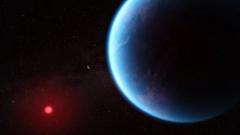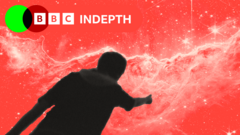In a groundbreaking study led by Cambridge's Prof. Nikku Madhusudhan, new evidence has surfaced suggesting that the distant planet K2-18b may harbor life. Utilizing the advanced capabilities of NASA's James Webb Space Telescope (JWST), the research team identified molecules associated with biological processes, sparking excitement in the scientific community.
K2-18b, which is approximately 2.5 times the size of Earth and orbiting a red dwarf star 700 trillion miles away, exhibited a remarkable concentration of chemicals such as dimethyl sulphide (DMS) and dimethyl disulphide (DMDS). These gases are typically associated with life on Earth, primarily produced by marine phytoplankton and bacteria. Prof. Madhusudhan expressed optimism about confirming these results within a year or two, stating, “This is the strongest evidence yet there is possibly life out there."
However, researchers caution that while the findings are promising, they are still tentative. The detection reached a level of certainty known as three sigma (99.7%), which falls short of the five sigma threshold (99.99999%) required for a definitive discovery. Moreover, the researchers and independent scientists emphasize the need for caution, as alternative explanations for the detected gases’ origins can arise.
Prof. Catherine Heymans, Scotland’s Astronomer Royal, noted the possibility that these gases could arise from geological activities unrelated to life, reminding us that the universe hosts multiple mysteries. Despite the uncertainty, the research group is actively collaborating with others to explore whether DMS and DMDS can be synthesized through non-biological processes.
Amidst this excitement, scientists continue to debate the underlying circumstances of K2-18b’s atmosphere and surface composition. The detection of these gases signals a potential vast ocean on the planet, yet interpretations vary on whether it is a liquid body of water or a sea of molten rock.
In this quest for understanding the cosmos, Prof. Madhusudhan and his team remain hopeful that their research might revolutionize how we perceive extraterrestrial life, stating, “Decades from now, we may look back at this point in time and recognize it was when the living universe came within reach.” The findings have been detailed in The Astrophysical Journal Letters, revealing a frontier in astrobiology with K2-18b at its center.
K2-18b, which is approximately 2.5 times the size of Earth and orbiting a red dwarf star 700 trillion miles away, exhibited a remarkable concentration of chemicals such as dimethyl sulphide (DMS) and dimethyl disulphide (DMDS). These gases are typically associated with life on Earth, primarily produced by marine phytoplankton and bacteria. Prof. Madhusudhan expressed optimism about confirming these results within a year or two, stating, “This is the strongest evidence yet there is possibly life out there."
However, researchers caution that while the findings are promising, they are still tentative. The detection reached a level of certainty known as three sigma (99.7%), which falls short of the five sigma threshold (99.99999%) required for a definitive discovery. Moreover, the researchers and independent scientists emphasize the need for caution, as alternative explanations for the detected gases’ origins can arise.
Prof. Catherine Heymans, Scotland’s Astronomer Royal, noted the possibility that these gases could arise from geological activities unrelated to life, reminding us that the universe hosts multiple mysteries. Despite the uncertainty, the research group is actively collaborating with others to explore whether DMS and DMDS can be synthesized through non-biological processes.
Amidst this excitement, scientists continue to debate the underlying circumstances of K2-18b’s atmosphere and surface composition. The detection of these gases signals a potential vast ocean on the planet, yet interpretations vary on whether it is a liquid body of water or a sea of molten rock.
In this quest for understanding the cosmos, Prof. Madhusudhan and his team remain hopeful that their research might revolutionize how we perceive extraterrestrial life, stating, “Decades from now, we may look back at this point in time and recognize it was when the living universe came within reach.” The findings have been detailed in The Astrophysical Journal Letters, revealing a frontier in astrobiology with K2-18b at its center.







